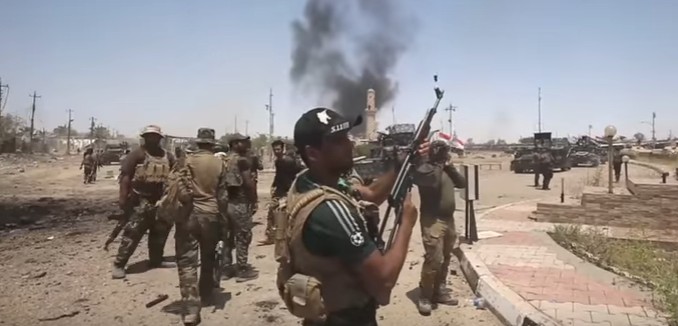Since American troops withdrew from Iraq, Iran has come to “dominate” its western neighbor in “military, political, economic and cultural affairs,” The New York Times reported Sunday.
Tim Arango, the paper’s Baghdad bureau chief, detailed Iran’s history of working to subvert Iraq when it was ruled by Saddam Hussein, and then after the 2003 American invasion.
Iran’s control of Iraq is now so pervasive, that if you “walk into almost any market in Iraq and the shelves are filled with goods from Iran — milk, yogurt, chicken. Turn on the television and channel after channel broadcasts programs sympathetic to Iran,” Arango wrote.
Building materials similarly come from Iran, “and in the halls of power in Baghdad, even the most senior Iraqi cabinet officials have been blessed, or bounced out, by Iran’s leadership.”
In addition, a law passed last year by Iraq’s parliament has permanently integrated Iran-sponsored Shiite militias into Iraq’s army.
Having established effective political and military control over its former enemy, Iran is using its position to build “a corridor from Tehran to the Mediterranean … to move men and guns to proxy forces in Syria and Lebanon.” Establishing the corridor will give Iran the ability “to retain land access to its most important spinoff in the region, Hezbollah, the military and political force that dominates Lebanon and threatens Israel.”
Whereas the United States hoped that the 2003 invasion would unseat a tyrant and viewed “Iraq as a potential cornerstone of a democratic and Western-facing Middle East,” Iran saw “a chance to make a client state of Iraq, a former enemy against which it fought a war in the 1980s so brutal, with chemical weapons and trench warfare, that historians look to World War I for analogies.”
Iran’s takeover of Iraq has heightened tensions among the country’s Sunni minority population and spurred regional Sunni powers such as Saudi Arabia “to oppose Iranian expansionism.”
After Iran-backed militias took over the Diyala Province in eastern Iraq from ISIS, they began “securing their next interests here: marginalizing the province’s Sunni minority and securing a path to Syria,” Arango reported. Even though ISIS was defeated in Diyala two years ago, “thousands of Sunni families still fill squalid camps, unable to return home.”
Iran’s domination of Iraq has not come without generating some resentment. While Iran makes common cause with Iraq’s majority Shiites, “Iraqi Shiites share a faith with Iran, but they also hold close their other identities as Iraqis and Arabs.”
In one incident, Qais al-Khazali, a Shiite militia leader, railed against the U.S., Turkey, and Saudi Arabia while addressing a group of Iraqi university students in April. When a poet in his entourage stood up and began praising Gen. Qassem Soleimani, the head of Iran’s Islamic Revolutionary Guard Corps-Qods Force, the students started yelling, “Iran out! Iran out!”
The protesting students “quickly learned how dangerous it could be to stand up to Iran these days,” Arango wrote. “First, militiamen began threatening to haul them off. Then media outlets linked to the militias went after them, posting their pictures and calling them Baathists and enemies of Shiites.” Ultimately, at least four students were suspended for a year from school.
“We thought we had only one hope, the university,” said Mustafa Kamal, one of the suspended students. “And then Iran also interfered there.”
Iran’s efforts to spread its message in Iraqi schools are part of its mission “to control the youth, and to teach them the Iranian beliefs, through Iraqis who are loyal to Iran,” said Beriwan Khailany, an Iraqi lawmaker.
Iran’s influence runs so deep in Baghdad that when a Shiite militia kidnapped a royal Qatari hunting party in 2015, Doha didn’t initially contact Iraqi authorities, but Iran and its allied militia. Viewing the incident as a demonstration of his government’s weakness at the hands of Iran, Prime Minister Haider al-Abadi pushed back and seized the ransom designated for the Iran-backed militias. “In Iraq, the kidnapping episode was seen as a violation of the country’s sovereignty and emblematic of Iran’s suffocating power over the Iraqi state,” Arango reported.
Israeli Brig.-Gen. (ret.) Dr. Shimon Shapira of the Jerusalem Center for Public Affairs wrote earlier this month that “Iran has virtually won control over Iraq, a key segment of the ‘Shiite arc’ land route from Tehran, through Iraq and Syria, to southern Lebanon and the Mediterranean.”
He noted that Iran’s Supreme Leader Ayatollah Ali Khamenei told Abadi, the Iraqi prime minister, in their latest meeting that the Shiite militias are an “important and blessed phenomenon” and would play an “important” part in governing Iraq after the defeat of ISIS.
Shapira blamed the rise of the militias (and with them, the rise of Iran’s influence in Iraq) to “decisions taken years earlier by Washington to avoid any confrontation with the growing Shiite militias in Iraq at the same time as the drawdown of U.S. forces in Iraq during the Obama Administration,” which left a “vacuum” for Iran to exploit.
In I Saw the U.S. Hand Iraq Over to the Iranians. Is the Whole Region Next?, which was published in the February 2015 issue of The Tower Magazine, Middle East analyst Michael Pregent observed that statements by Obama administration officials that Washington and Tehran were aligned in the fight against ISIS were “interpreted as a green light for Iran to increase its sphere of influence in Iraq.”
Pregent also observed at the time that Iran “believes that the U.S. wants a nuclear deal so badly that it will tacitly approve Iran’s activities throughout the Middle East—including in Syria and Yemen—by downplaying Iranian influence or ignoring it altogether.”
[Photo: The Guardian / YouTube ]




